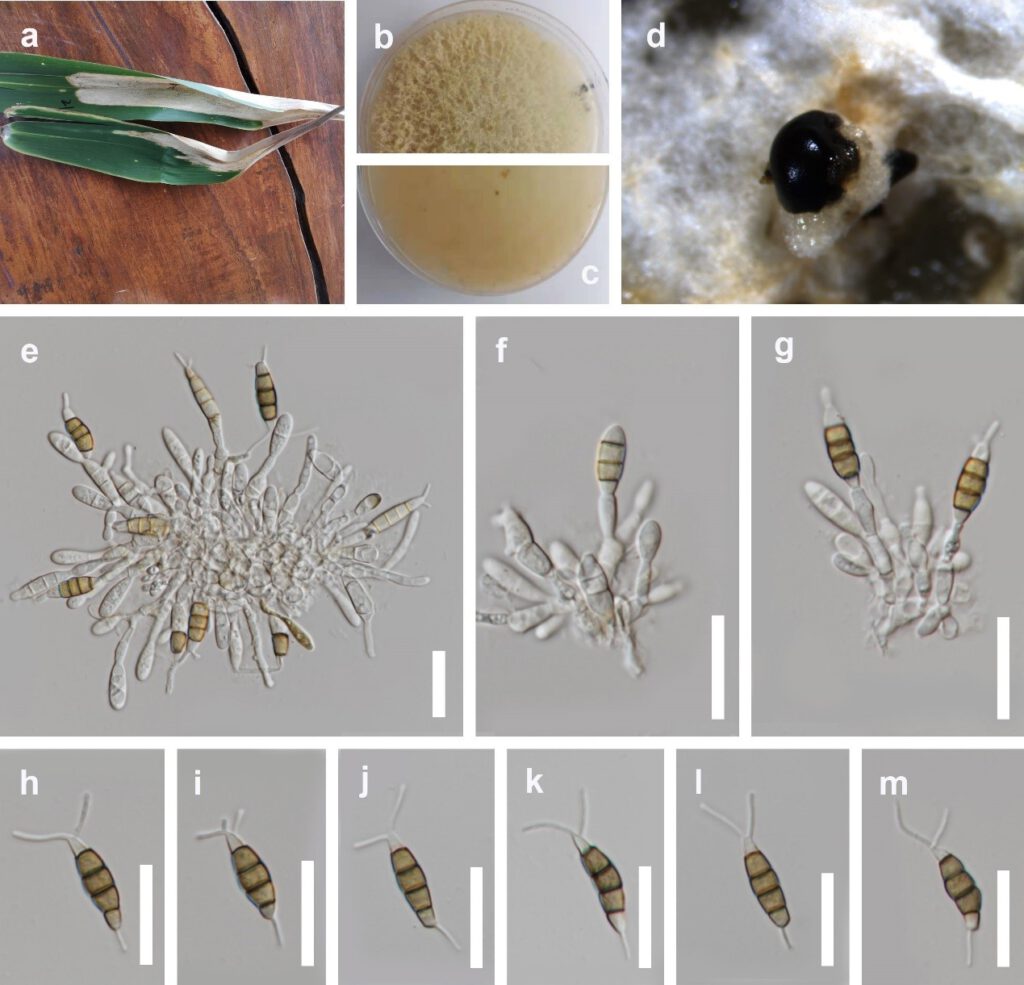Pestalotiopsis chiangmaiensis Y.R. Sun & Yong Wang bis, in Sun, Jayawardena, Sun & Wang, Microbiology Spectrum: e03987-22, 12 (2023)
Index Fungorum number: IF 571225; MycoBank number: MB 571225; Facesoffungi number: FoF 04525;
Etymology – Refers to the location where the fungus was encountered.
Holotype – MFLU 22-0164
Associated with leaf strips of Phyllostachys edulis. Sexual morph: Not observed. Asexual morph: Conidiomata on PDA pycnidial, subglobose to globose, solitary or aggregated, dark, semi-immersed or partly erumpent; exuding black conidial masses. Conidiophores hyaline, smooth, simple, reduced to conidiogenous cells. Conidiogenous cells 5.0–11.0 × 1.5–3.0 μm, cylindrical to sub-cylindrical or ampulliform to lageniform, hyaline, smooth. Conidia pale brown, fusiform, straight to slightly curved, (3 to) 4 septate, 16 to 26 × 4 to 7 μm (x̄ = 21 × 5 μm, n = 40), L/W ratio of 4.2; basal cell obconic with a truncate base, hyaline or sometimes pale brown, smooth walled, 2 to 6 μm long; three median cells 10 to 16 μm long (x̄ = 14 μm, n = 40), pale brown, concolorous, wall rugose, septa darker than the rest of the cell, somewhat constricted at the septa; second cell from base pale brown, 3 to 6 μm long; third cell brown, 3 to 6 μm long; fourth cell brown, 3 to 6 μm long; apical cell 2 to 5 μm long, hyaline, conic to acute; with 2 (to 3) tubular appendages on the apical cell, inserted at different loci in a crest at the apex of the apical cell, unbranched, 8 to 13 μm long; single basal appendage 2 to 7 μm, unbranched, tubular, centric.
Culture characteristics – Colonies on PDA reaching 5–6 cm diam after 7 d at 25 °C, colonies filamentous to circular, medium dense, aerial mycelium on surface flat or raised, with filiform (curle) margin, fluffy, white from above and below; fruiting bodies black.
Material examined – Thailand, Chiang Mai Province, Mae Taeng District, Mushroom Research Center, leaf strip of Phyllostachys edulis (Poaceae), 15 July 2020, Y.R. Sun, M18 (MFLU 22-0164, holotype); ex-type culture, MFLUCC 22-0127.
Notes – Pestalotiopsis chiangmaiensis formed a distinct lineage and was sister to P. smilacicola and P. dracontomelon in the phylogenetic tree (Fig. 11). It differs by longer conidiogenous cells (5 to 11 μm versus 1 to 4 μm) than P. smilacicola and shorter apical appendages (8 to 13 μm versus 10 to 22 μm) than P. dracontomelon. In addition, there are 14 bp different (without gap, 474 bp) in the tef1-α region between P. chiangmaiensis (MFLUCC 22-0127) and P. smilacicola (MFLUCC 22-0125) and 15 bp different (without gap, 464 bp) between P. chiangmaiensis (MFLUCC 22-0127) and P. dracontomelon (MFLUCC 10-0149). The PHI test on P. chiangmaiensis also showed that there is no significant recombination (Фw = 0.26) between P. chiangmaiensis and its closely related taxa (Fig. 10a). Therefore, we introduce P. chiangmaiensis as a new species.

Figure 13 – Pestalotiopsis chiangmaiensis (MFLU 22-0164, holotype). a Host. b, c Cultures. d Colonies on PDA. e–g Conidiogenous cells and developing conidia. h–m Conidia. Scale bars: e–m = 20 µm.
